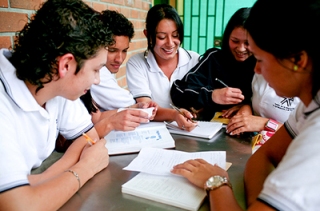21st-century skills. The flipped classroom. Blended learning. With too many buzzwords in education, it can be tough for any parent to keep track.
One helpful tag for high school parents to understand these days is project-based learning.
The instructional move towards, in which students learn through creating a project, is becoming a common practice in middle and high schools across the country. Organizations for example the New Tech Network, Expeditionary Learning and Big Picture are helping project-based learning to flourish from coast to coast. And education professors are teaching aspiring teachers about the method, which some say is not completely new.

When done fine, project-based learning can improve a student's education, turning teenagers into more engaged learners, experts say. But like many education techniques, it is only effective when teachers use it as designed.
In a characteristic classroom that uses project-based learning, students are put in groups and asked to complete a project with some real-world application. The project is not an addition at the end of a lesson, in other words, but rather vehicle for learning.
Students might be asked to use their math skills to put together a food budget for a wedding, for example, or draw on their chemistry knowledge to advise a vineyard on what type of soil balance it needs to grow a certain type of grape.?
Students are frequently asked to present their final product to adults who have a vested?interest in the results of the project - the couple, say or vineyard owner - who then assess students and play a role in determining their grade.
Makayla Ferman, a junior at Texas?' Belton New Tech High @ Waskow?, says one of her favourite projects involved using her geometry skills to help plan the number of parking spaces essential in a new school parking lot. Students were asked to present their recommendations and then school officials choose the best plan.
"The part I liked best about the project was that we were actually making an impact," she says. "We were doing it for our school."
Project-based learning is often interdisciplinary in nature, meaning that students may complete a project that draws from both their history and science classes. Schools that practice the advance often have an emphasis on technology that they say helps student's research and design creative, professional-looking final projects. The teaching method is mainly popular in STEM schools.
Unlike in traditional classrooms, instructors practicing project-based learning put a minimal emphasis on lecturing, in its place serving as a guide for students as they work throughout their projects. Advocates say the approach gives students a way to show they have learned their class content, as also honing their communication, collaboration and problem-solving skills -kinds of abilities employers want to find in the workplace.

Ferman says she is impressed with the skills she is picked up.
"Before I came to this school I was really shy and I was afraid to talk to new people," she says. "But now my presentation skills are pretty awesome."
As the term project-based learning only became popular in recent years, idea has been around for at least a hundred or so, says Nancy Niemi, associate professor and head of education program at the University of New Haven. She traces the idea back to John Dewey, an education reformer and philosopher from the 19th and 20th century who believed that school work must be hands on and tied to the community.
In education, she says, there is a tendency to constantly observe old techniques, pluck the best from them, tweak them and call them new. The field has completed that with project-based learning, she says.
"It should not be sold as the latest and greatest thing that is going to save public education," Niemi says. "It is a great teaching and learning technique that can be used very well or not very well."
To have an effective project-based learning environment, teachers require to have a structure in place so that students have an idea of how they must move through the process, she says. They also need to play close attention to group dynamics, knowing while to intervene if a group has stalled.
With a great educator at the helm of the classroom, Niemi and others says project-based learning can make students more engaged and creative.
"The difference in the kids, it's been phenomenal," says Kris Schrotenboer, who has been teaching English in Grand Rapids, Mich., for 20 years, but only started using project-based learning 5 or 6 years ago. "Kids who do not usually have a voice in the room suddenly have a voice and feel like they have value."